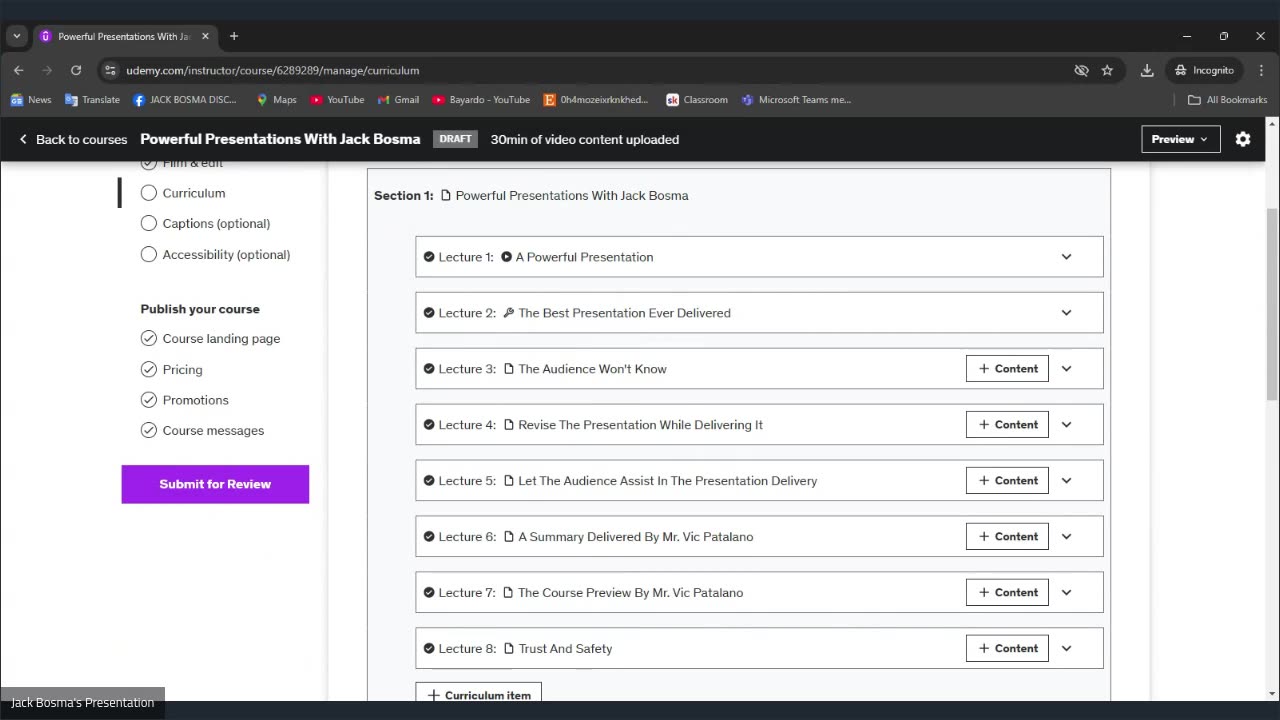Premium Only Content

Powerful Presentations With Jack Bosma #2
Powerful Presentations With Jack Bosma #2
Powerful Presentation Considerations
Creating a memorable and impactful presentation requires careful planning and execution. Below are key considerations to ensure your presentation stands out:
1. Know Your Audience
Understand Their Needs: Tailor your content to the audience’s interests, knowledge level, and expectations.
Demographics: Consider age, profession, cultural background, and preferences.
Engagement Style: Decide if your audience prefers interaction, data-driven insights, or storytelling.
2. Define Your Purpose
Objective Clarity: Be clear about the goal of your presentation—whether to inform, persuade, motivate, or entertain.
Outcome Focus: Plan your content to achieve the desired audience response or action.
3. Plan a Strong Structure
Introduction: Briefly outline what your presentation will cover and why it’s relevant.
Body: Organize main points logically, using sub-points, examples, and supporting evidence.
Conclusion: Recap key messages and end with a call to action or thought-provoking statement.
4. Develop Engaging Content
Brevity and Clarity: Use concise language to communicate your message effectively.
Variety: Incorporate anecdotes, data, visuals, and questions to maintain interest.
Relatable Examples: Use real-world applications or stories to make your points resonate.
5. Leverage Visual Aids
Minimalist Design: Use clean, simple slides that enhance your message without overwhelming.
Charts and Graphics: Present data visually to simplify complex information.
Multimedia: Add videos or animations sparingly to complement key points.
6. Focus on Delivery
Practice: Rehearse your presentation to build confidence and refine timing.
Body Language: Use gestures and expressions to reinforce your enthusiasm.
Vocal Dynamics: Vary tone, pitch, and pace to keep your delivery engaging.
Eye Contact: Connect with individuals in the audience to establish rapport.
7. Encourage Interaction
Questions: Pose open-ended questions to involve your audience.
Activities: Use polls, discussions, or group tasks to promote participation.
Feedback: Adjust your approach based on audience reactions during the presentation.
8. Incorporate Data and Credibility
Use Reliable Sources: Ensure all data and research are accurate and trustworthy.
Simplify Complex Information: Present data visually or through analogies for better understanding.
Highlight Relevance: Show how the data applies to your audience's concerns or interests.
9. Anticipate and Prepare for Challenges
Q&A Preparation: Anticipate potential questions and prepare thoughtful answers.
Technical Backup: Have contingency plans for technical issues, such as offline copies of your presentation.
Flexibility: Be prepared to adapt your presentation based on time constraints or audience feedback.
10. Evaluate and Refine
Feedback: Gather input from peers or a test audience to improve your content and delivery.
Self-Assessment: Reflect on your performance to identify strengths and areas for improvement.
Continuous Improvement: Update your presentation skills and materials based on new tools, techniques, and feedback.
Key Takeaway
A powerful presentation is the result of thoughtful preparation, engaging content, and confident delivery. By considering your audience, purpose, and execution, you can create a meaningful and lasting impact.
Let's collaborate!
Thanks,
Jack Bosma
https://meetn.com/jackbosma
tutorjacknetwork@gmail.com
"Inspect what you expect."
-
 43:39
43:39
WickedVirtue
1 hour agoLate Night Spooky Plays
5.25K -
 2:04:02
2:04:02
Glenn Greenwald
5 hours agoTrump and Rubio Apply Panama Regime Change Playbook to Venezuela; Michael Tracey is Kicked-Out of Epstein Press Conference; RFK Senate Hearing | SYSTEM UPDATE #508
80.8K94 -
 58:36
58:36
Total Horse Channel
7 hours ago2025 CSI3* A Coruña Porsche - Grand Prix
10.9K -
 2:10:32
2:10:32
megimu32
3 hours agoOTS: Mighty Morphin Power Rangers & the 90s Movie That Defined a Generation
8.69K4 -
 1:14:53
1:14:53
Badlands Media
17 hours agoThe SITREP Ep. 128
26.5K6 -
 LIVE
LIVE
BubbaSZN
3 hours ago🔴 LIVE - FORTNITE WITH NEW KEYBOARD
112 watching -
 2:17:29
2:17:29
Mally_Mouse
4 hours agoThrowback Thursday! Let's Play: Cuphead
15.9K1 -
 LIVE
LIVE
StevieTLIVE
4 hours agoWarzone HYPE Duos with GloryJean
49 watching -
 1:05:11
1:05:11
Donald Trump Jr.
6 hours agoBuilding the Future with American Bitcoin, Plus Eric's Triggered Debut! | TRIGGERED Ep.272
113K56 -

RaikenNight
6 hours ago $0.02 earnedThe Baldur Boyz are on a Mission to Save the City
1.82K